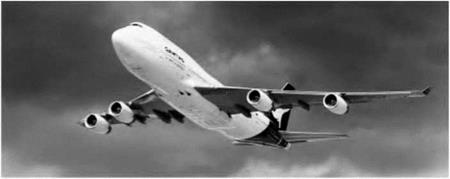The four forces
Now, what are the forces which keep the aeroplane in its state of steady level flight? First the lift, which will be vertically upwards since the direction of motion is horizontal. This we have created with the express object of keeping the aeroplane in the air by opposing the force of gravity, namely, the weight. But we can only produce lift if the aeroplane is moved forward and for this we need the thrust provided by the propeller or jets. We also know that the forward motion will be opposed by the drag.
The aeroplane, therefore, can be said to be under the influence of four main forces – 1. The Tift, L, acting vertically upwards through the Centre of Pressure.
|
|
Fig 5A Long haul, large capacity
This Boeing 747-400 ‘Jumbo’ has 350 seats, and a range of 13 528 km that could take it from Europe to Australia non-stop.
2. The Weight of the aeroplane, W, acting vertically downwards through the Centre of Gravity.
3. The Thrust of the engine, T, pulling horizontally forwards.
4. The Drag, D, acting horizontally backwards.
Just as for certain purposes it is convenient to consider all the weight as acting through one point, called the centre of gravity, or all the lift as acting at the centre of pressure, so we may imagine the resultant of all the drag acting at one point which, for convenience, we will call the centre of drag. Its actual position depends on the relative resistance of different parts of the aeroplane.












